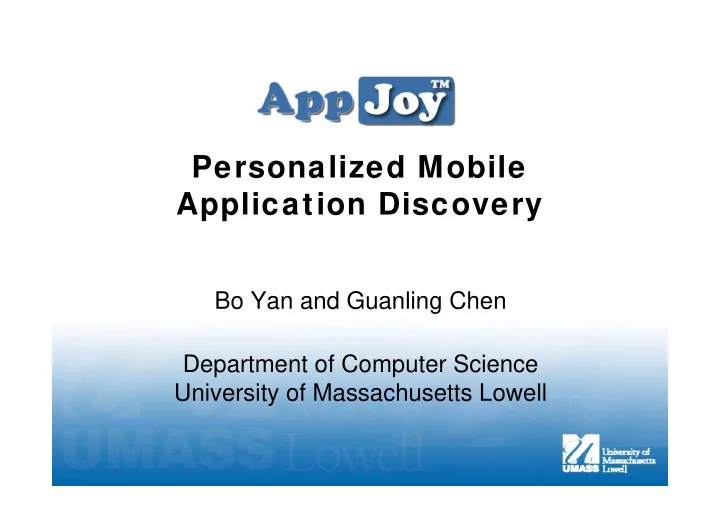

Personalized Mobile Application Discovery Bo Yan and Guanling Chen Department of Computer Science University of Massachusetts Lowell
How to Find Apps • Search by keywords or browse by categories • Personalized recommendation according to user download history or ratings – Users often install apps to try them out without uninstalling when dislike them – Lack of ratings • Angry Birds, ratings from 7% downloads – Outdated ratings for continuously updated apps
AppJoy • Usage Score – Implicitly measure how the apps are used by users without requiring explicit ratings – Adaptive to the changes of user taste • Collaborative Filtering – Compute similarity by usage score – Predict user preference from the similar apps of user’s installation
Talk Outline • Recommendation • Implementation • Evaluation Results • Conclusion and Future Works
How to Describe User Preference • Passively observe how the apps are being used – The more an app being used the more the user likes it – The usage patterns of the different apps thus can be considered as an objective reflection of the user’s taste • Usage Score – R ecency, F requency and D uration – The weight shows the importance
Adaptiveness • Recency is adaptive to the changes of usage • Give frequency and duration a penalty according to recency
Slope One Prediction • Similarity • Predict the usage score reflecting how the user like an app
Talk Outline • Recommendation • Implementation • Evaluation Results • Conclusion and Future Works
Challenges • How to measure app usage since there is no API provided by Android SDK • Usability Considerations • How to identify users
Monitoring App Usage • No API to acquire app usage – Check every one second which app’s activity is in the foreground • Services are always running – Focus on interaction time • Run a service in the background to do this monitoring
Usability Considerations • Slow to load – Provide a sense of immediacy – Retrieve the list of recommended apps in a background thread – Download the icons of apps using a thread pool – The perceived wait time is shorten • Difficult to read and use – Bigger fonts and larger areas
Cookie-based User Auth • Anonymously usage records – Need to identify usage records for personalized recommendation • Cookie-based Authentication – Identify users by device – Merge the device identifier and the server token into Cookie
Talk Outline • Recommendation • Implementation • Evaluation Results • Conclusion and Future Works
AppJoy Characteristics • Release since February 2010 • More than 4,600 users from 10,190 cities in 99 countries • More than 100 types of smartphones • 50% of users stayed with AppJoy 10+ days • A relatively stable organic growth without any advertisement
Usage Report • Installed apps, from 3 to 910 (61) – frequently-used apps, from 1 to 73 (8) • 40% of users installed less than 18 of the total 42 categories – Exploratory users installed more apps in each category • 753 users used AppJoy for 30+ days – 50% of apps are installed for 11 days – 27% of apps are installed for 30 days
Recommendation Effectiveness • 4.96% of all recommended apps are installed – 7.39% of users installed more than 10
Recommendation Accuracy • Can be improved, RMSE = 0.9749 – Netflix Cinematch, 0.9514 – Bellkor’s Progmatic Chaos, 0.8554 • However, more than 80% accuracy for more than 80% of the users
Recommendations is More Popular • 2,603 users (v2 and v3) – 597 apps installed through AppJoy – 14,330 apps not installed through AppJoy
Meeting Users’ Needs • 597 recommended apps – 839 users installed them through AppJoy – 1496 users installed them not through AppJoy
More Interaction Time • 839 users who installed recommended apps through AppJoy – interacted more with recommended apps
Talk Outline • Recommendation • Implementation • Evaluation Results • Conclusion and Future Works
Discussion • iPhone or Windows Mobile • Context-aware recommendation • The little-changed recommendations from relatively stable usage pattern • Usage record filter against malicious attackers with huge faked usage patterns
Conclusion • AppJoy – Use collaborative filtering to make personalized mobile application recommendation based on the user’s actual usage pattern – Completely automatic without requiring manual input – Adaptive to the potential changes of the user’s application taste – Accurate by consuming low battery
Future Work • Usability and user study • Improve recommendation algorithm – Integrate the user context • Perform detailed analysis of app usage pattern at a much larger scale • Promotion
Questions and Answers http://appjoy.cs.uml.edu
More recommend